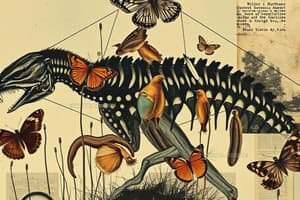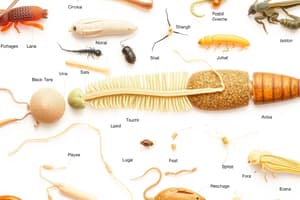Podcast
Questions and Answers
What are fungi?
What are fungi?
What are eubacteria?
What are eubacteria?
What are plantae?
What are plantae?
What are archaebacteria?
What are archaebacteria?
Signup and view all the answers
What are animalia?
What are animalia?
Signup and view all the answers
In the discipline of taxonomy, what is a domain?
In the discipline of taxonomy, what is a domain?
Signup and view all the answers
What are the 3 domains into which organisms can be grouped?
What are the 3 domains into which organisms can be grouped?
Signup and view all the answers
What characteristic is shared by all members of the domain Eukarya?
What characteristic is shared by all members of the domain Eukarya?
Signup and view all the answers
What must you find out about a prokaryote to know which domain it belongs to?
What must you find out about a prokaryote to know which domain it belongs to?
Signup and view all the answers
Which phylum includes humans, snakes, and sharks?
Which phylum includes humans, snakes, and sharks?
Signup and view all the answers
The group of organisms that can be larger than a kingdom is called a _____
The group of organisms that can be larger than a kingdom is called a _____
Signup and view all the answers
A prokaryote whose cell walls contain peptidoglycan belongs to the domain _________
A prokaryote whose cell walls contain peptidoglycan belongs to the domain _________
Signup and view all the answers
Unicellular organisms sometimes found in hot springs are part of the domain?
Unicellular organisms sometimes found in hot springs are part of the domain?
Signup and view all the answers
The domain Eukarya includes which kingdoms?
The domain Eukarya includes which kingdoms?
Signup and view all the answers
The kingdom protista contains?
The kingdom protista contains?
Signup and view all the answers
Mushrooms belong to the _______ kingdom
Mushrooms belong to the _______ kingdom
Signup and view all the answers
The kingdom plantae contains primarily
The kingdom plantae contains primarily
Signup and view all the answers
The organisms found in the kingdom Animalia are?
The organisms found in the kingdom Animalia are?
Signup and view all the answers
Into how many domains are organisms divided?
Into how many domains are organisms divided?
Signup and view all the answers
The unicellular prokaryotes that make up the domain bacteria are also classified in the ____- kingdom
The unicellular prokaryotes that make up the domain bacteria are also classified in the ____- kingdom
Signup and view all the answers
The prokaryotes that live in extreme environments are classified in the _________ kingdom
The prokaryotes that live in extreme environments are classified in the _________ kingdom
Signup and view all the answers
Which taxon includes the most specific characteristics?
Which taxon includes the most specific characteristics?
Signup and view all the answers
Which taxon includes the broadest characteristics?
Which taxon includes the broadest characteristics?
Signup and view all the answers
Which taxon includes more species, an order or a family?
Which taxon includes more species, an order or a family?
Signup and view all the answers
Which taxon includes only organisms that can successfully interbreed?
Which taxon includes only organisms that can successfully interbreed?
Signup and view all the answers
If two organisms belong to the same family, what other taxonomic groups do the organisms have in common?
If two organisms belong to the same family, what other taxonomic groups do the organisms have in common?
Signup and view all the answers
Which class does not include animals that have hair or fur?
Which class does not include animals that have hair or fur?
Signup and view all the answers
Study Notes
Fungi
- Heterotrophic organisms with cell walls made of chitin.
Eubacteria
- Prokaryotic organisms characterized by cell walls containing peptidoglycan.
Plantae
- Multicellular autotrophs that possess cell walls made of cellulose, primarily involved in photosynthesis.
Archaebacteria
- Prokaryotes with cell walls that do not contain peptidoglycan, often found in extreme environments.
Animalia
- Multicellular eukaryotes lacking cell walls and chloroplasts, predominantly heterotrophic.
Protista
- A diverse group of eukaryotic organisms that can be unicellular, colonial, or multicellular.
Taxonomy Concepts
- Domain: The largest, most inclusive taxonomic group.
- Organisms are classified into three domains: bacteria, archaea, and eukarya.
- All members of the domain Eukarya are eukaryotes, which means they possess a defined nucleus.
Classification of Prokaryotes
- To determine the domain of a prokaryote, one must identify if its cell wall contains peptidoglycan.
- Prokaryotes with cell walls containing peptidoglycan belong to the domain Bacteria.
- Prokaryotes found in extreme environments fall under the kingdom Archaebacteria.
Phylum Chordata
- Includes species such as humans, snakes, and sharks.
Kingdom and Domain Relationships
- The domain Eukarya encompasses four kingdoms: Protista, Plantae, Fungi, and Animalia.
- Kingdom Protista consists of both unicellular and multicellular organisms.
Additional Organism Characteristics
- Mushrooms are classified under the kingdom Fungi.
- Kingdom Plantae is mainly composed of photosynthetic autotrophs.
- Kingdom Animalia consists of multicellular heterotrophs.
Taxonomic Hierarchies
- Organisms are divided into three domains.
- Eubacteria is the kingdom comprising unicellular prokaryotes of the domain Bacteria.
- Archaebacteria is the kingdom for prokaryotes that thrive in extreme conditions.
Taxonomic Specificity
- The species taxon represents the most specific classification level.
- The kingdom taxon represents the broadest classification level.
- An order includes more species than a family.
- The species taxon includes organisms that can interbreed successfully.
Overlapping Taxonomic Groups
- Organisms belonging to the same family also share the same order, class, phylum, and kingdom.
- Amphibia is a class that does not include mammals, so it does not contain animals with hair or fur.
Studying That Suits You
Use AI to generate personalized quizzes and flashcards to suit your learning preferences.
Description
Test your knowledge of biological classifications with this worksheet flashcard quiz. It covers the major groups such as fungi, eubacteria, plantae, archaebacteria, and animalia, detailing their unique characteristics. Perfect for biology students needing a quick review!




